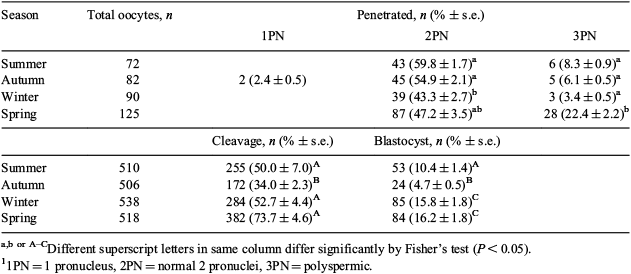254 IN VITRO BLASTOCYST PRODUCTION FROM PREPUBERTAL GOAT OOCYTES ACCORDING TO SEASON
M. G. Catalá A , M. Roura A , S. Hammami A , M. Rodriguez A , D. Izquierdo A and M. T. Paramio ADep. CAA, Fac. Vet., Universitat Autònoma de Barcelona, Barcelona, Spain
Reproduction, Fertility and Development 27(1) 216-217 https://doi.org/10.1071/RDv27n1Ab254
Published: 4 December 2014
Abstract
In our laboratory, we have been working for more than 20 years on in vitro embryo production from prepubertal goat oocytes. We have observed significant differences on blastocyst production according to the season of year. The present study is aimed to asses these differences in summer, autumn, winter, and spring. Oocytes with more than 3 compact cumulus layers (cumulus-oocyte complex, COC) and homogeneous cytoplasm were obtained after slicing prepubertal goat ovaries (45-day-old Murciano-Granadina rearing animals) recovered from slaughterhouse. Groups of 30 COC were matured in 100-µL drops of TCM199 medium (10% FBS) for 24 h with 5% CO2 and humidified atmosphere. Fresh buck semen (pool of 3 males) was selected by swim-up and capacitated with 0.05 mg mL–1 of heparin for 45 min. The IVF was performed by transferring 20 oocytes to 100-μL drops of Tyrode's medium with 4 × 106 capacitated sperm with 5% CO2 and humidity. After 17 h of IVF, a sample of oocytes was fixed in ethanol:acetic (3 : 1) for staining (1% lacmoid) to assess nuclear stage (Table 1). At 20 h post-insemination (pi), groups of 10 presumptive zygotes were transferred to 10-μL drops of SOF medium (10% FBS) under paraffin oil in a humidified atmosphere with 90% N2 for 8 days. Cleavage rate was evaluated at 48 h pi, and blastocyst rate was recorded at Day 8 pi (Table 1). Table 1 shows a decrease in normal pronuclear formation during winter (43%) and spring (47%). However, winter (16%) and spring (16%) produced significantly more blastocysts than summer (10%) and autumn (5%). Similar results were found by Sousa et al. (2014 Theriogenology 82, 1149–1162) in adult goats producing significantly higher blastocysts in the anoestrus season. We hypothesise that prepubertal goat oocytes in winter and spring may have a better cytoplasmic quality, producing more blastocyst even though the penetration rate is significantly lower than in autumn. In conclusion, under in vitro conditions and using fresh semen, the rate of penetration, cleavage, and blastocysts in prepubertal goats is influenced by season. Further studies in oocyte and sperm quality should be done to clarify this result.

|


